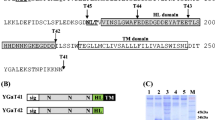Summary
Various gene fusions between the arginine permease and invertase have been constructed in order to obtain information about whether part of the CAN1 gene product can induce secretion of biologically active invertase missing its own signal sequence. A construction containing 30 N-terminal amino acid residues of the CAN1 gene product fused to invertase was not secreted. When the CAN1 portion was elongated to 477 or 560 amino acid residues, secretion of the fusion proteins was observed. A fusion lacking 59 amino acids at the amino-terminal end of the arginine permease was also secreted. These results indicate that the amino-terminal end of the arginine permease is neither sufficient nor essential for membrane insertion; instead this enzyme should contain an internal targeting sequence facilitating secretion. Some general implications on the biosynthesis and topology of membrane proteins are also discussed as well as the homology with histidine permease.
Similar content being viewed by others
References
Ammerer G (1983) Expression of genes in yeast using the ADC1 promoter. Methods Enzymol 101:192–201
Beggs JD (1978) Transformation of yeast by a replicating hybrid plasmid. Nature 275:104–108
Blobel G, Dobberstein B (1975) Transfer of proteins across membranes: I. Presence of proteolytically processed and unprocessed nascent immunoglobulin light chains on membranebound ribosomes of murine myeloma. J Cell Biol 67:835
Brandl CJ, Deber CM (1986) Hypothesis about the function of membrane-buried proline residues in transport proteins. Proc Natl Acad Sci USA 83:917–921
Carlson M, Botstein D (1982) Two differentially regulated mRNAs with different 5′-ends encode secreted and intracellular forms of yeast invertase. Cell 28:145–154
Carlson M, Taussig R, Kustu S, Botstein D (1983) The secreted form of invertase in Saccharomyces cerevisiae is synthesized from mRNA encoding a signal sequence. Mol Cell Biol 3:439–447
Chan RK, Otte CA (1982) Isolation and genetic analysis of Saccharomyces cerevisiae mutants supersensitive to G1 arrest by a-factor and α-factor pheromones. Mol Cell Biol 2:11–20
Cooper TG (1982) Transport in Saccharomyces cerevisiae. In: Strathern JN, Jones EW, Broach JR (eds) The Molecular Biology of the Yeast Saccharomyces: Metabolism and Gene Expression. Cold Spring Harbor Laboratory, Cold Spring Harbour, New York, pp 399–461
Devillers-Thiery A, Giraudat J, Bentaboulet M, Changeux JP (1983) Complete mRNA coding sequence of the acetylcholine binding α-subunit of Torpedo marmorata acetylcholine receptor: A model for the transmembrane organization of the polypeptide chain. Proc Natl Acad Sci USA 80:2067–2071
Douglas MG, Geller BL, Emr SD (1984) Intracellular targeting and import of an F1-ATPase β-subunit-β-galactosidase hybrid protein into yeast mitochondria. Proc Natl Acad Sci USA 81:3983–3987
Dunn R, McCoy J, Simsek M, Majumdar A, Chang SH, Raj-Bhandary UL, Khorana HG (1981) The bacteriorhodopsin gene. Proc Natl Acad Sci USA 78:6744–6748
Emr SD, Schekman R, Flessel MC, Thorner J (1983) An MFα1-SUC2 (α-factor-invertase) gene fusion for study of protein localization and gene expression in yeast. Proc Natl Acad Sci USA 80:7080–7084
Emr SD, Schauer I, Hansen W, Esmon P, Schekman R (1984) Invertase β-galactosidase hybrid proteins fail to be transported from the endoplasmic reticulum in Saccharomyces cerevisiae. Mol Cell Biol 4:2347–2355
Emr SD, Vassarotti A, Garrett J, Geller BL, Takeda M, Douglas MG (1986) The amino terminus of the yeast F1-ATPase β-subunit precursor functions as a mitochondrial import signal. J Cell Biol 102:523–533
Fink GR, Styles CA (1972) Curing of a killer factor in Saccharomyces cerevisiae. Proc Natl Acad Sci USA 69:2846–2849
Hoffmann W (1985) Molecular characterisation of the CAN1 locus in Saccharomyces cerevisiae. J Biol Chem 260:11831–11837
Kurjan J, Herskowitz I (1982) Structure of a yeast pheromone gene (MFα): a putative α-factor precursor contains four tandem copies of mature α-factor. Cell 30:933–943
Kyte J, Doolittle RF (1982) A simple method for displaying the hydropathic character of a protein. J Mol Biol 157:105–132
Mueckler M, Caruso C, Baldwin SA, Panico M, Blench I, Morris HR, Allard WJ, Lienhard GE, Lodish HF (1985) Sequence and structure of a human glucose transporter. Science 229:941–945
Nasmyth KA, Reed SI (1980) Isolation of genes by complementation in yeast: molecular cloning of a cell-cycle gene. Proc Natl Acad Sci USA 77:2119–2123
Norrander J, Kempe T, Messing M (1983) Construction of improved M13 vectors using oligodeoxynucleotide-directed mutagenesis. Gene 26:101–106
Tanaka J, Fink GR (1985) The histidine permease gene (HIP1) of Saccharomyces cerevisiae. Gene 38:205–214
Taussig R, Carlson M (1983) Nucleotide sequence of the yeast SUC2 gene for invertase. Nucleic Acids Res 11:1943–1954
Tschopp J, Esmon PC, Schekman R (1984) Defective plasma membrane assembly in yeast secretory mutants. J Bacteriol 160:966–970
Valenzuela P, Medina A, Rutter WJ, Ammerer G, Hall BD (1982) Synthesis and assembly of hepatitis B virus surface antigen particles in yeast. Nature 298:347–350
Viera J, Messing J (1982) The pUC plasmids, an M13mp7-derived system for insertion mutagenesis and sequencing with synthetic universal primers. Gene 19:259–268
Zerial M, Melancon P, Schneider C, Garoff H (1986) The transmembrane segment of the human transferrin receptor functions as a signal peptide. EMBO J 5:1543–1550
Author information
Authors and Affiliations
Additional information
Communicated by W. Goebel
Rights and permissions
About this article
Cite this article
Hoffmann, W. CAN1-SUC2 gene fusion studies in Saccharomyces cerevisiae . Molec Gen Genet 210, 277–281 (1987). https://doi.org/10.1007/BF00325694
Received:
Issue Date:
DOI: https://doi.org/10.1007/BF00325694




